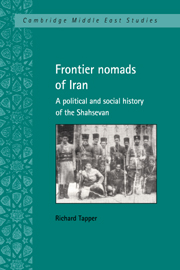Book contents
- Frontmatter
- Contents
- List of illustrations
- Preface
- Acknowledgments
- Note on transliteration
- Glossary
- 1 Writing tribal history
- PART I The Safavid state and the origins of the Shahsevan
- 2 ‘Shahsevani’: Safavid tribal policy and practice
- 3 Shahsevan traditions
- 4 Moghan and Ardabil in Safavid times
- PART II The rise of the Shahsevan confederacy
- PART III The Shahsevan tribes in the Great Game
- PART IV The end of the tribal confederacy
- Appendices
- Bibliography
- Index of topics
- Index of places, peoples, persons, dynasties, parties, companies
- Index of authors quoted or discussed
- Index of tribal names
- Plate section
4 - Moghan and Ardabil in Safavid times
Published online by Cambridge University Press: 05 March 2012
- Frontmatter
- Contents
- List of illustrations
- Preface
- Acknowledgments
- Note on transliteration
- Glossary
- 1 Writing tribal history
- PART I The Safavid state and the origins of the Shahsevan
- 2 ‘Shahsevani’: Safavid tribal policy and practice
- 3 Shahsevan traditions
- 4 Moghan and Ardabil in Safavid times
- PART II The rise of the Shahsevan confederacy
- PART III The Shahsevan tribes in the Great Game
- PART IV The end of the tribal confederacy
- Appendices
- Bibliography
- Index of topics
- Index of places, peoples, persons, dynasties, parties, companies
- Index of authors quoted or discussed
- Index of tribal names
- Plate section
Summary
The eastern Transcaucasus has always offered a highly favourable environment for both pastoral and agricultural activities. High mountains, with abundant summer pasturages, command the vast and fertile Shirvan, Qara-Bagh and Moghan plains of the lower Aras and Kor rivers, which provide correspondingly extensive winter grazing. The plains, a favourite wintering place of conquerors, also invite the construction of large-scale irrigation works, such as the canal restored by Timur in Moghan, which seems to have continued in operation throughout Safavid times. Shirvan was second only to Gilan to the south as producer of raw silk. The area is a natural crossroads, and trade and travel between Russia and Iran and between Anatolia and Central Asia passed through or close by. From Safavid times, travellers and merchants from Europe commonly journeyed overland through Russia and took ship on the Caspian at Astrakhan to land at Shirvan and halt awhile at the growing trading centre of Shamakhi, before crossing the Kor at Javat and passing via Moghan and Ardabil into central Iran, and beyond to India.
It is not surprising that the whole area was long the object of intense struggle between powerful rulers. The Safavids gained control at the beginning of the sixteenth century, but had difficulty keeping it from the Ottomans, the Russians and various Caucasian powers, and when the dynasty crumbled in the early eighteenth century, the area was divided briefly between the Ottomans and the Russians. It was the latter who eventually, after a further eighty years of Iranian hegemony, annexed most of the area for good.
- Type
- Chapter
- Information
- Frontier Nomads of IranA Political and Social History of the Shahsevan, pp. 72 - 92Publisher: Cambridge University PressPrint publication year: 1997



